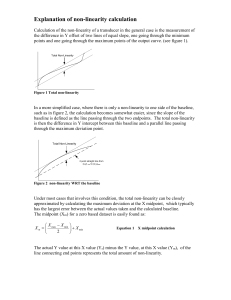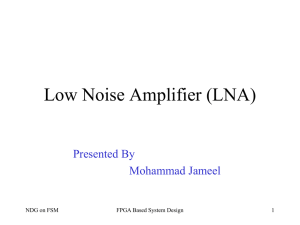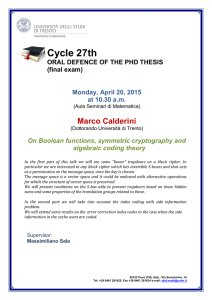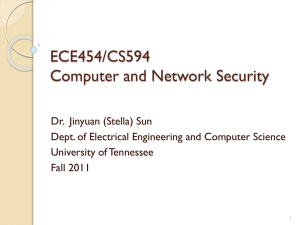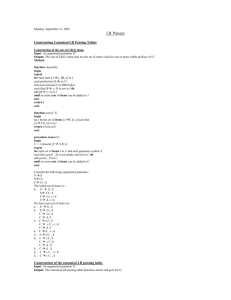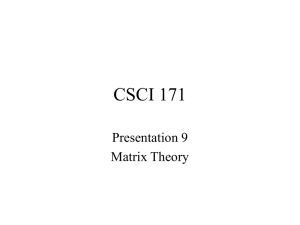3. New method M ethod – GaT
advertisement
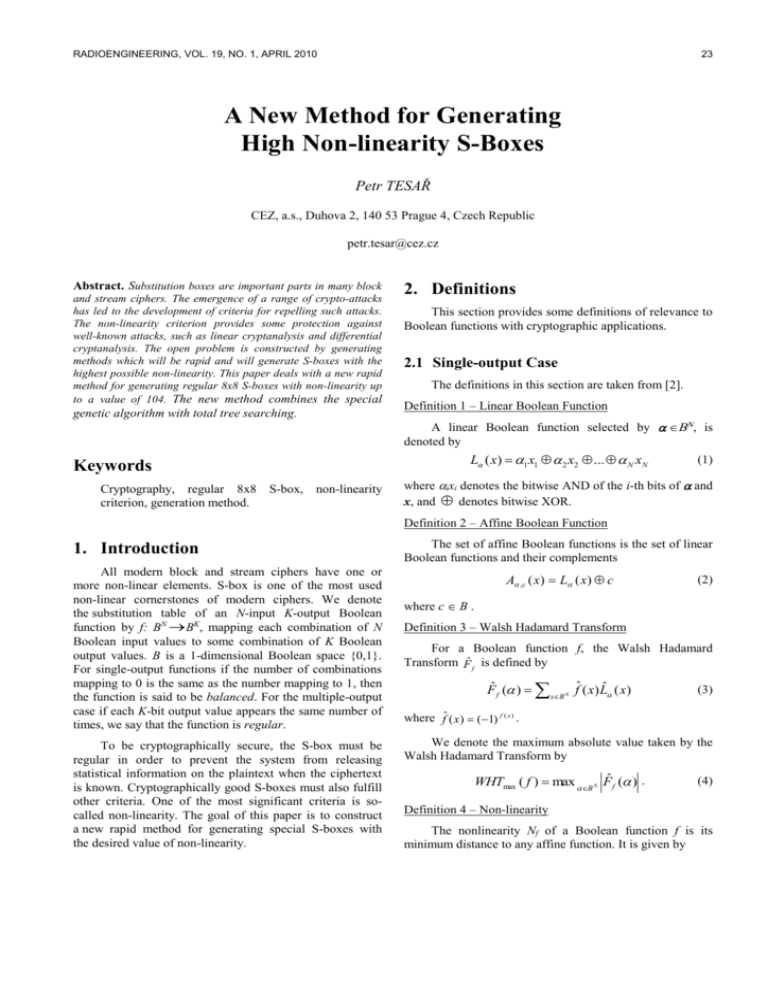
RADIOENGINEERING, VOL. 19, NO. 1, APRIL 2010
23
A New Method for Generating
High Non-linearity S-Boxes
Petr TESAŘ
CEZ, a.s., Duhova 2, 140 53 Prague 4, Czech Republic
petr.tesar@cez.cz
Abstract. Substitution boxes are important parts in many block
and stream ciphers. The emergence of a range of crypto-attacks
has led to the development of criteria for repelling such attacks.
The non-linearity criterion provides some protection against
well-known attacks, such as linear cryptanalysis and differential
cryptanalysis. The open problem is constructed by generating
methods which will be rapid and will generate S-boxes with the
highest possible non-linearity. This paper deals with a new rapid
method for generating regular 8x8 S-boxes with non-linearity up
to a value of 104. The new method combines the special
genetic algorithm with total tree searching.
This section provides some definitions of relevance to
Boolean functions with cryptographic applications.
2.1 Single-output Case
The definitions in this section are taken from [2].
Definition 1 – Linear Boolean Function
A linear Boolean function selected by , is
denoted by
L ( x) 1 x1 2 x2 ... N xN
Keywords
Cryptography, regular 8x8
criterion, generation method.
2. Definitions
S-box,
non-linearity
(1)
where ixi denotes the bitwise AND of the i-th bits of and
x, and denotes bitwise XOR.
Definition 2 – Affine Boolean Function
1. Introduction
All modern block and stream ciphers have one or
more non-linear elements. S-box is one of the most used
non-linear cornerstones of modern ciphers. We denote
the substitution table of an N-input K-output Boolean
function by f: BN BK, mapping each combination of N
Boolean input values to some combination of K Boolean
output values. B is a 1-dimensional Boolean space {0,1}.
For single-output functions if the number of combinations
mapping to 0 is the same as the number mapping to 1, then
the function is said to be balanced. For the multiple-output
case if each K-bit output value appears the same number of
times, we say that the function is regular.
To be cryptographically secure, the S-box must be
regular in order to prevent the system from releasing
statistical information on the plaintext when the ciphertext
is known. Cryptographically good S-boxes must also fulfill
other criteria. One of the most significant criteria is socalled non-linearity. The goal of this paper is to construct
a new rapid method for generating special S-boxes with
the desired value of non-linearity.
The set of affine Boolean functions is the set of linear
Boolean functions and their complements
A ,c ( x) L ( x) c
(2)
where c B .
Definition 3 – Walsh Hadamard Transform
For a Boolean function f, the Walsh Hadamard
Transform F̂ f is defined by
Fˆ f ( ) xB N fˆ ( x) Lˆ ( x)
(3)
where fˆ ( x) (1) f ( x ) .
We denote the maximum absolute value taken by the
Walsh Hadamard Transform by
WHTmax ( f ) max B N Fˆ f ( ) .
(4)
Definition 4 – Non-linearity
The nonlinearity Nf of a Boolean function f is its
minimum distance to any affine function. It is given by
P.TESAŘ, A NEW METHOD FOR GENERATING HIGH NON-LINEARITY S-BOXES
24
1
N f (2 N WHT max ( f )) .
2
(5)
It is known that for N even, the maximum non-linearity
attainable is [8]
N
N max ( N ) 2 N 1 2 2
1
(6)
but such functions (bent functions) are not balanced.
2.2 Multi-output Case
The NxK S-box is a Boolean function with N-bit input
and K-bit output Boolean variables x = (x1, x2,…xN) and
y = (y1, y2,…,yK). The NxK S-box is a set of K single-output
Boolean functions (f1, f2,…,fK) where fi(x) = yi for
i = 1,…,K.
Each β BK defines a function that is a linear
combination f(x) of the K outputs of the S-box.
f ( x) 1 f1 ( x) .... K f K ( x) .
(7)
In paper [7] the modified hill climbing method is considered. The method enables the application of hill climbing techniques to modify the bent functions used to design
balanced highly non-linear Boolean functions. The main
idea of the method is to invert the hill climbing algorithm.
A bent function is used as input data instead of a randomly
generated Boolean function, and the non-linearity of the
bent function is decreased to a required value, instead of
increasing the non-linearity of a randomly generated Boolean function. In the 8-input case, balanced Boolean functions are constructed with non-linearity up to 116.
Evolutionary searching methods have many variants.
A common schema is:
a) We have an initial set of objects (S-boxes or Boolean
functions), known as a farm. Let M be the size of the
farm. The initial farm is mostly produced by a random
search.
b) We derive successors from the objects of the farm.
We count the cost function for all successors. We order them by this cost function. The best M of them
become the new farm.
For each such function f the non-linearity is defined
in the usual way.
c) We repeat step b) until the object with the desired
feature is found or the STOP criterion is fulfilled.
There are 2K-1 non-trivial functions obtainable in this
way. The notion of non-linearity is readily extended to the
NxK S-box. Non-linearity is the worst (lowest) non-linearity of all 2K-1 non-trivial single output functions obtained
as indicated above.
There are many parameters – the number M, the genetic method for creating successors, the number of successors, the type of cost function, and the STOP criteria.
The crucial parameter is the type of cost function. Older
versions used the non-linearity value as the cost function. In
paper [3], the authors applied genetic algorithms followed
by hill climbing to evolve 8xK regular S-boxes for K =
1,…,8. The available limit of non-linearity was 100 in these
cases for 8x8 S-boxes. A much smarter cost function was
published in [2]. This cost function WHS (see Definition 5)
has two variables and thus defines the broad set of cost
functions. A new search technique inspired by the cooling
processes of molten metals – annealing – together with the
cost function WHS is proposed in [2]. For 8x8
S-boxes this method repeatedly generates 8x8 S-boxes with
non-linearity 102.
Only regular S-boxes with N = K = 8 will be examined in this paper. The main reason is that a byte (= 8 bits)
is a basic computer memory element, and there are many
byte-oriented ciphers.
3. Generating Methods - Overview
Three main classes of methods for generating S-boxes
and Boolean functions with the desired non-linearity are
given in the publicly-available literature:
1. Random searching
2. Construction methods
3. Evolutionary (or genetic) searching
The simplest method is random searching. Nonlinearity 98 is the highest value for this method in public
papers ([1] and [3]) for 8x8 S-boxes. Four 8x8 S-boxes
with non-linearity 100 were found in an experiment by the
author with 50 million random 8x8 S-boxes. Non-linearity
112 is the highest value for balanced Boolean functions [7].
Hill climbing, as a representative of construction
methods, is taken from papers [1] and [4]. The available
limit of non-linearity is 100 for 8x8 S-boxes [1] and 114 for
balanced Boolean functions [7].
Paper [6] provides the hill climbing method to
produce 9x32 S-boxes with good cryptographic properties.
In paper [5] Millan et al. applied a genetic algorithm
to construct cryptographically strong balanced Boolean
functions with non-linearity up to 116, in the 8-input case.
4. New Method – GaT
The new method presented in this paper combines the
special genetic algorithm with total tree searching. The
name of the method is GaT ("Genetic and Tree"). The best
version of the GaT algorithm uses the special cost function
WHS from [2].
RADIOENGINEERING, VOL. 19, NO. 1, APRIL 2010
25
Definition 5 – Cost function WHS
For an NxK S-box P the cost function WHSR,X(P) is
defined by
WHS R , X ( P)
Fˆ ( w) X
R
(8)
of overall searched S-boxes by MxC. If the number of
iterations is greater than I, or if the number of overall
searched S-boxes is greater than Z, then GoTo STEP 10,
otherwise GoTo STEP 3.
where X and R are real-valued parameters and Fˆ ( w) is the
Walsh Hadamard Transform by Definition 3 equation (3).
Low WHS values are better.
STEP 3: If any S-box from the population has non-linearity
equal to NEL, then GoTo STEP 9, or if any S-box from the
population has non-linearity equal to NT, then GoTo STEP
4. Otherwise order the S-boxes by the cost function CF and
the best M of them become the new farm. Then GoTo
STEP 2.
In [2], R=3.0 and the X integer value from the interval
<-4, +4> were used with a special search algorithm - annealing.
STEP 4: Let P1 be the S-box with non-linearity greater or
equal to NT and with cost function CF(P1). Set CN:=NT.
Search step by step overall N(P1), until
For an algorithm that generates good 8x8 S-boxes, it
will be shown that a much better (R, X) parameter pair
exists. In a huge experiment with the R integer value from
the interval <3, 25> and the X integer value from the interval <-25, 25>, all 1173 pairs (R, X) were rated by some
heuristic measure by the author, and the best pair was R=7
and X=21. The best pair of the subset from paper [2] was
R=3 and X=4 (832. position).
a) find S-box with non-linearity equal to NEL, then
GoTo STEP 9, or
B K wB N
The general schema of the GaT method is taken from
the author.
STEP 0: We define the parameters of the method,
especially the integer N - dimension of the NxN S-box,
where N=8, integer M - number of S-boxes in the farm,
integer C - number of successors for each farm’s S-box,
integer I - maximum number of iterations in the genetic part
of the algorithm, even integer NT - non-linearity value to go
to the tree part of the algorithm, integer Z - maximum
number of overall searched S-boxes and even integer NEL desired non-linearity value. We define the cost function CF.
If NEL is less or equal to NT, then the tree part of the
algorithm will not be used.
STEP 1: Set zero to number of iterations. Set MxC to number of overall searched S-boxes. Randomly generate MxC
S-boxes. This set is called the population. For all S-boxes
from the population, count the cost function CF and nonlinearity. Set as current the best non-linearity from the
population to the integer CN. If any S-box from the population has non-linearity greater or equal to NEL, then GoTo
STEP 9 or if any S-box from the population has non-linearity greater or equal to NT, then GoTo STEP 4. Otherwise
order the S-boxes by the cost function CF and the best M of
them become a farm. Then GoTo STEP 2.
STEP 2: For each S-box P from the farm, randomly select
C successors from the neighborhood N(P). The neighborhood N(P) is a set of all Nx(N-1) S-boxes by simply swapping the output values associated with two input values of
P. The original P can also be selected, and repetitions of
successors are allowed. Now we have the new population.
Then, for all S-boxes from the new population, count the
cost function CF and the non-linearity. Update CN. Increase the number of iterations by one. Increase the number
b) find S-box with non-linearity greater than CN, then
GoTo STEP 5, or
c) find S-box with non-linearity equal to CN and a better
cost function than CF(P1), then GoTo STEP 5, or
d) no S-box from N(P1) has values to go to option a), b)
or c), or the number of overall searched S-boxes is
greater than Z, then GoTo STEP 10.
STEP 5: Let P2 be an S-box from option STEP 4 b) or c).
Set CN:=non-linearity of P2.
Save P1 with ordinal number of P2 over N(P1) into a LIFO
(=Last In First Out) stack and set j=2 (ordinal number of
the diagnostic S-box). Then GoTo STEP 6.
STEP 6: Search step by step overall N(Pj) until:
a) find S-box with non-linearity equal to NEL, then
GoTo STEP 9, or
b) find S-box with non-linearity greater than CN, then
GoTo STEP 7, or
c) find S-box with non-linearity equal to CN and a better
cost function than CF(Pj), then GoTo STEP 7, or
d) the number of overall searched S-boxes is greater than
Z, then GoTo STEP 10, or
e) no S-box from N(Pj) has values to go to option a), b)
or c), then GoTo STEP 8.
STEP 7: Set j:=j+1. Let Pj be the S-box from the option
STEP 6 b) or c). Set CN:=non-linearity of Pj. Save Pj-1 with
ordinal number of Pj over N(Pj-1) into the LIFO stack. Then
GoTo STEP 6.
STEP 8: Set j:=j-1. If j=0, then GoTo STEP 10, else resume Pj from LIFO stack and GoTo STEP 6.
STEP 9: STOP algorithm. S-box with non-linearity equal or
greater than NEL has been found.
STEP 10: STOP algorithm. S-box with non-linearity equal
or greater than NEL was not found.
P.TESAŘ, A NEW METHOD FOR GENERATING HIGH NON-LINEARITY S-BOXES
26
5. Experimental Results
We can compare the main types of algorithms for
generating 8x8 S-boxes with the desired non-linearity
value. The criterion is the number of overall searched Sboxes to discover the S-box with the desired non-linearity
value. Tab. 1 includes the mean values of the overall
searched 8x8 S-boxes for the five methods under investigation. The results were obtained by the author. The result
of the Hill Climbing method is taken from paper [1].
Method \ Non-linearity
Random searching
Hill Climbing
GaT with CF=Non-linearity
GaT with CF=WHS3,4
GaT with CF=WHS7,21
98
695
NA
171
217
64
100
12.5 M
2500
29648
2714
522
102
NRP
NRP
NRP
79385
9859
104
NRP
NRP
NRP
NRP
3.239
M
Tab. 1. Mean values of criterion (M is million, NA means not
available, and NRP means the method is not able to
produce repeatedly.).
The values of Tab. 1 are obtained on the basis of
many huge experiments. For example, 70 S-boxes with
non-linearity 104 were generated.
The optimal parameters of the GaT method for
generating 8x8 S-boxes with NEL=104 are
M=C=10,
I=200,
NT=102,
Z=9000000,
CF=WHS7,21.
6. Conclusion
The new GaT method with cost function WHS7,21 is
statistically faster (significance level 1%) than the openly
public methods known to the author for generating 8x8
S-boxes with non-linearity 98 – 102, and it is capable of
repeatedly producing 8x8 S-boxes with non-linearity 104.
The GaT parameters for generating small S-boxes are
not optimal. Better parameters for these small S-boxes will
be sought in future, and the results will be compared with
the standard methods.
A future plan is to examine GaT with other criteria,
for example autocorrelation.
References
[1] MILLAN, W. How to improve the nonlinearity of bijective SBoxes. In Australian Conference on Information Security and
Privacy, 1998, p. 181 - 192.
[2] CLARK, J. A., JACOB, J. L., STEPNEY, S. The design of SBoxes by simulated annealing. New Generation Computing
Archive, September 2005, vol. 23, issue 3.
[3] MILLAN, W., BURNETT, L., CARTER, G., CLARK, A.,
DAWSON,
E.
Evolutionary
heuristics
for
finding
cryptographically strong S-Boxes. Springer-Verlag, Lecture Notes
in Computer Science, 1999, vol. 1726, p. 263 – 274.
[4] MILLAN, W., CLARK, A., DAWSON, E. Boolean function
design using hill climbing methods. In 4th Australian Conference
on Information Security and Privacy. Ed. Bruce Schneier,
Springer-Verlag, Lecture Notes in Computer Science, 1999, vol.
1587, p. 1 – 11.
[5] MILLAN, W., CLARK, A., DAWSON, E. Heuristic design of
cryptographically strong balanced Boolean functions. In Advances
in Cryptology EUROCRYPT´98, Springer-Verlag, Lecture Notes
in Computer Science, 1998, vol. 1403, p. 489 – 499.
[6] BURNETT, L., CARTER, G., DAWSON, E., MILLAN, W.
Efficient methods for generating MARS-Like S-Boxes. In 7th
International Workshop on Fast Software Encryption 2000, Bruce
Schneier, ed. Springer-Verlag, Lecture Notes in Computer
Science, 2001, vol. 1978, p. 300 – 314.
[7] IZBENKO, Y., KOVTUN, V., KUZNETSOV, A. The Design of
Boolean Functions by Modified Hill Climbing Method
(datasheet). 17 pages. [Online] Cited 2008. Available at:
http://eprint.iacr.org/2008/111.pdf
[8] Mac WILLIAMS, F.J., SLOANE, N.J.A. The Theory of Error
Correcting Codes. Amsterdam: North-Holland Publishing
Company, 1978.
The method is not capable of producing 8x8 S-boxes
with non-linearity higher than 104.
The 5x5, 6x6 and 7x7 S-boxes were also generated by
GaT, for guidance. The results are shown in Tab. 2.
S-box
5x5
6x6
7x7
Non-linearity
10
22
48
Tab. 2. Maximum obtained non-linearity.
About the Author
Petr TESAŘ was born in Prague. He received his M.Sc. in
mathematics from the Math. Phys. Faculty of Charles
University Prague in 1974. His research interests include
cryptography algorithms and e-signatures.
